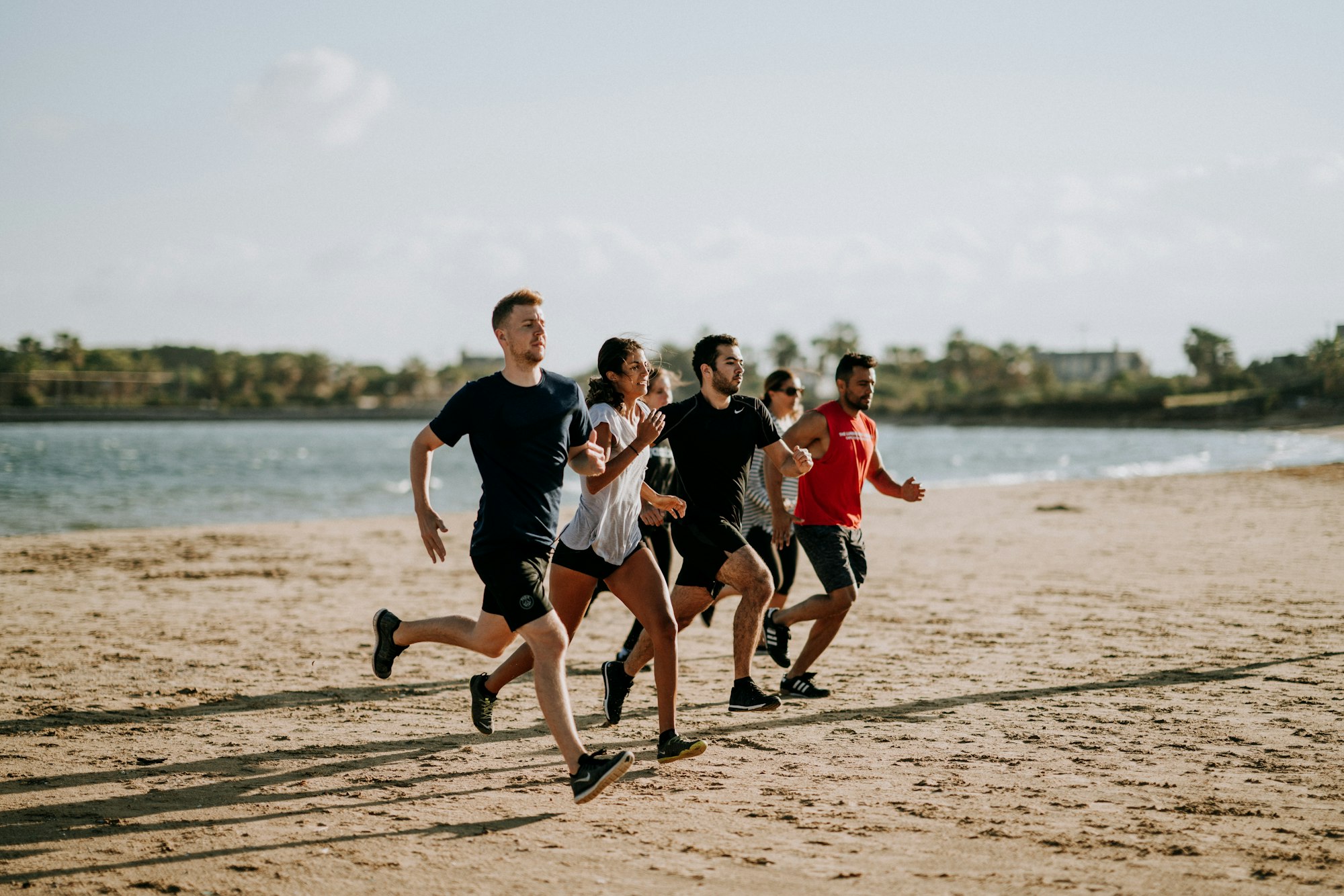Physical activity plays a vital role in maintaining sound psychophysiological health and well-being. Regular physical activity is proven to prevent a wide range of noncommunicable diseases. Despite the well-documented benefits, a large proportion of the world population do not participate in regular physical activity.
In this article, I will cover the definition, benefits, recommended guidelines, current statistics, how to get started, and important things to consider.
What is Physical Activity?
Definition of Physical Activity
According to the World Health Organization (WHO):
Physical Activity is defined as any bodily movement produced by skeletal muscles that requires energy expenditure.
Physical activity includes all kinds of motion including sport, exercise, and other forms of human movement such as yoga, dance, and commuting to and from work.
Common ways people choose to stay active include walking, jogging, running, cycling, and other recreational forms of exercise and sport.
Benefits of Physical Activity
Engaging in regular physical activity has the following health benefits:
- Improves mental health
- Improves mood and emotions
- Reduces anxiety and depressive symptoms
- Helps regulate levels of chemicals in the brain, such as serotonin, endorphins, and stress hormones
- Helps lose excess body fat and maintain a healthy body weight
- Lowers risk for cardiovascular disease
- Lowers blood pressure and cholesterol level
- Reduces Type 2 Diabetes and metabolic syndrome
- Lowers risk for developing commonly occurring cancers
- bladder, breast, colon (proximal and distal), endometrium, esophagus (adenocarcinoma), kidney, lung, and stomach (cardia and non-cardia adenocarcinoma)
- Strengthens bones and muscles
- slows loss of bone density
- lowers risk of hip fracture
- reduces risk of falling
- helps alleviate arthritis and rheumatic conditions
- increases muscle mass and strength
- Facilitates recovery from periods of injury and/or hospitalisation
- Helps regulate sleep and diet for a better quality of life
- Increases the chances of living longer and healthier
Current Statistics on Physical Activity
- More than 25% of the world’s adult population (around 2 billion people) are insufficiently active
- Globally, 1 in 3 females and 1 in 4 males do not engage in adequate physical activity
- 81% of adolescents aged 11-17 years are insufficiently physically active
- Levels of physical activity have not improved since 2001
- Levels of physical inactivity are twice as high in high-income countries compared to low-income countries
- 26% of men and 35% of women are insufficiently physically active in high-income countries
- 12% of men and 24% of women are insufficiently physically active in low-income countries
- Plummeting physical activity levels are attributed to inaction during leisure time and sedentary behaviour, and passive modes of transportation
Despite the well-documented benefits of regular physical activity, recent trends have indicated that people are not engaging in recommended levels of physical activity to reap the health benefits. And, therefore, there is an insistent need to motivate people to increase the amount of physical activity they undertake.
How much Physical Activity is recommended
WHO outlines different guidelines for different age- and specific-population groups on how much physical activity is needed to maintain good health.
Infants (less than 1 year old)
In a typical day, Infants (less than 1 year old) should:
- be physically active several times a day in a variety of ways
- when sedentary, engaging in meaningful activities, especially with a caregiver is encouraged
- have 12-17 hours of good quality sleep
- not be restrained for more than 1 hour at a time
- screen time is not recommended
Children (1-2 years of age)
In a typical day, Children (1-2 years of age) should:
- spend at least 180 minutes engaged in different types of physical activities
- when sedentary, engaging in meaningful activities, especially with a caregiver is encouraged
- have 11-14 hours of good quality sleep, including naps, with regular sleep and wake-up routines
- not be restrained for more than 1 hour at a time
- screen time is not recommended
Children (3-4 years of age)
In a typical day, Children (3-4 years of age) should:
- spend at least 180 minutes engaged in different types of physical activities (of which at least 60 minutes is moderate- to vigorous-intensity physical activity, spread throughout the day)
- when sedentary, engaging in meaningful activities, especially with a caregiver is encouraged
- have 10-13 hours of good quality sleep, including naps, with regular sleep and wake-up routines
- limited and monitored screen time is recommended (not more than 1 hour)
- not be restrained or sedentary (sit) for more than 1 hour at a time
Children and Adolescents (aged 5-17 years of age)
In a typical week, Children and Adolescents (aged 5-17 years of age) should:
- spend at least an average of 60 minutes per day in moderate-to-vigorous intensity, mostly aerobic, physical activity, across the week
- incorporate vigorous-intensity aerobic activities, as well as those that strengthen muscle and bone, at least 3 days a week
- limit the amount of time spent being sedentary, particularly the amount of recreational screen time
Children and Adolescents living with disability
In a typical week, Children and Adolescents living with disability should:
- do at least an average of 60 minutes per day of moderate-to-vigorous intensity, mostly aerobic, physical activity, across the week
- incorporate vigorous-intensity aerobic activities, as well as those that strengthen muscle and bone, at least 3 days a week
- limit the amount of time spent being sedentary, particularly the amount of recreational screen time
Pregnant and postpartum women
In a typical week, Pregnant and postpartum women (without contraindication) should:
- do at least 150 minutes of moderate-intensity aerobic physical activity throughout the week
- incorporate a variety of aerobic and muscle-strengthening activities
- limit the amount of time spent being sedentary
Adults (aged 18-64 years of age)
In a typical week, Adults (aged 18-64 years of age) should:
- engage in at least 150-300 minutes of moderate-intensity aerobic physical activity, or at least 75-150 minutes of vigorous-intensity aerobic physical activity, or an equivalent combination of moderate- and vigorous-intensity activity throughout the week
- engage in muscle-strengthening activities at moderate or greater intensity that involve all major muscle groups on 2 or more days a week
- increase moderate-intensity aerobic physical activity to more than 300 minutes, or do more than 150 minutes of vigorous-intensity aerobic physical activity, or an equivalent combination of moderate- and vigorous-intensity activity throughout the week
- limit the amount of time spent being sedentary
Adults (aged 65 years of age and above)
In a typical week, Adults (aged 65 years of age and above) should:
- engage in varied multicomponent physical activity that emphasizes functional balance and strength training at moderate or greater intensity, on 3 or more days a week
- do at least 150-300 minutes of moderate-intensity aerobic physical activity, or at least 75-150 minutes of vigorous-intensity aerobic physical activity, or an equivalent combination of moderate- and vigorous-intensity activity throughout the week
- engage in muscle-strengthening activities at moderate or greater intensity that involve all major muscle groups on 2 or more days a week
- increase moderate-intensity aerobic physical activity to more than 300 minutes, or do more than 150 minutes of vigorous-intensity aerobic physical activity, or an equivalent combination of moderate- and vigorous-intensity activity throughout the week
People living with chronic conditions
In a typical week, people living with chronic conditions:
- should do at least 150-300 minutes of moderate-intensity aerobic physical activity, or at least 75-150 minutes of vigorous-intensity aerobic physical activity, or an equivalent combination of moderate- and vigorous-intensity activity throughout the week
- may also do muscle-strengthening activities at moderate or greater intensity that involve all major muscle groups on 2 or more days a week
- may increase moderate-intensity aerobic physical activity to more than 300 minutes, or do more than 150 minutes of vigorous-intensity aerobic physical activity, or an equivalent combination of moderate- and vigorous-intensity activity throughout the week
- as part of their weekly physical activity, older adults should engage in varied multicomponent physical activity that emphasizes functional balance and strength training at moderate or greater intensity, on 3 or more days a week
- should limit the amount of time spent being sedentary
Adults living with disability
In a typical week, Adults living with disability should:
- do at least 150-300 minutes of moderate-intensity aerobic physical activity, or at least 75-150 minutes of vigorous-intensity aerobic physical activity, or an equivalent combination of moderate- and vigorous-intensity activity throughout the week
- also do muscle-strengthening activities at moderate or greater intensity that involve all major muscle groups on 2 or more days a week
- increase moderate-intensity aerobic physical activity to more than 300 minutes, or do more than 150 minutes of vigorous-intensity aerobic physical activity, or an equivalent combination of moderate- and vigorous-intensity activity throughout the week
- as part of their weekly physical activity, older adults should engage in varied multicomponent physical activity that emphasizes functional balance and strength training at moderate or greater intensity, on 3 or more days a week
- try to be physically active while sitting or lying (e.g., upper-body led activities, inclusive and/or wheelchair-specific sport and activities)
- limit the amount of time spent being sedentary
How to get started with Physical Activity
You may engage in a wide range of physical activities to reap the mental health benefits.
Move in and around your home
A healthy lifestyle starts at home. Perhaps, start doing more chores at home. Clean the house, mow the lawn, sweep the patio or driveway, or wash the car.
Stretch more
If you find yourself sitting for long periods of time, perhaps in front of the TV or at your workstation, stand up and stretch. It is also a good idea to stretch in the morning and/or at the end of the day before bed. Nothing too strenuous though.
Walk more. Jog too!
Get active with your family, partner, and/or friends/neighbours. Go for regular jogs. Make it a social occurrence. If you have kids and/or pets, take them to your local park and play with a frisbee.
Practice Mindfulness
Integrating mindfulness practice in your daily life will help you live in the present moment with a sense of equanimity and calmness. Check out this article on how you could use two novel mindfulness practices in your life right now.
Make it fun
Choose an activity that you enjoy. Do not try to force yourself to do something that you either won't enjoy or is too arduous to do.
Eat healthy
Most people ignore this. Eating unhealthy food means your body is not getting the nutrition it requires to function optimally. In fact, if you have poor diet or eating habits, you may feel more tired after physical activity, which would affect your motivation and involvement.
Sleep hygiene
In addition to having a proper diet, you also need to give your body enough time to relax and recuperate. Ensure that you have a strict sleep routine in place.
Things to consider before getting started
Consult your regular GP
Before you start a new training goal, you must consult your regular physician. Discuss your goals with them and how you're planning to implement relevant actions. You must also discuss pertinent questions with them before you start. For instance, are you on any medications? Are there any potential risks that you need to consider? Do you have pre-existing injuries or vulnerabilities that you need to be mindful of? Your regular GP will have all your health issues on file. And so, they would be able to assist you with your queries.
Start slow
Sometimes people get too excited to start a new training goal. But remember, staying healthy is a long marathon, not a sprint. So start slow, focus on tasks at hand, and pace yourself.
Have a plan
Starting a new training goal with no plan is like trying to drive a car with no fuel: you're going nowhere! Create SMART goals and stick to a schedule.
Stay motivated
Motivation is one of the most influential factors in physical activity involvement. You may want to discuss your goals with a mental health professional. Alternatively, you may choose to contact me and we can craft a plan that will help you achieve your goals.
It is important to note that not all people who exercise enjoy the same mental health benefits from it. Some people may feel worse after exercising because they experience post-exertion malaise or withdrawal symptoms from the endorphins released during exercise. It is important for people to get the right type of exercise for their needs in order to get the most benefits out of it.
References
World Health Organization (2022). Physical Activity. https://www.who.int/health-topics/physical-activity
Australian Government Department of Health(2022). Physical activity and exercise guidelines. https://www.health.gov.au/health-topics/physical-activity-and-exercise/physical-activity-and-exercise-guidelines-for-all-australians













Discussion